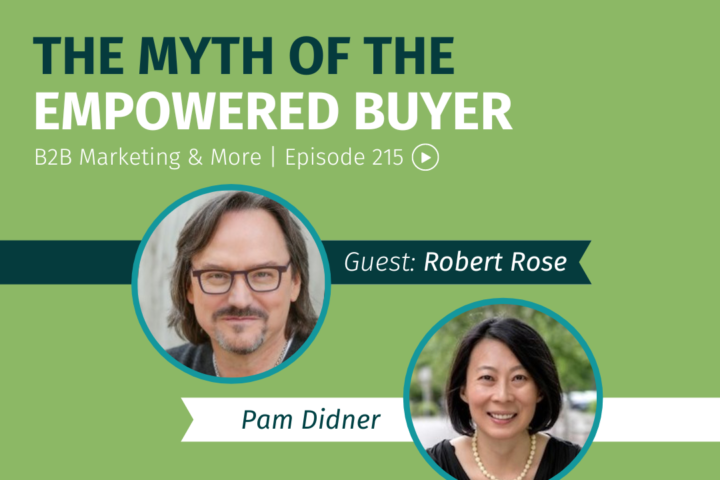
Welcome to another episode of 7-Minute Marketing with Pam. My name is Pam Didner, and I love sharing a little dose of B2B, digital, content marketing and sales enablement, seven minutes at a time.
I stayed in Lima for a couple of days before my trip to Machu Picchu and learned some interesting trivia about Lima and Peru that made me think about marketing… I know… Just can’t get marketing out of my mind even when I am on vacation.
Here are several things I’ve learned that reminded me of marketing
Lima receives only 0.3 inches of rain per year. Portland, Oregon, where I live, gets 44 inches of rain per year. People in Lima doesn’t know how to use an Umbrella. It’s the 2nd largest desert city after Cairo in Egypt. Ok, here is the interesting fact: Although it doesn’t rain, it often reaches close to 100% humidity. Because of high humidity, the weather is always cloudy and feels like it’s going to rain anytime, but it doesn’t. When I was there, it was overcast with the dark clouds hovering overhead, I thought it would rain anytime. No, it just stayed overcast the whole time, but the air felt damp. My jacket felt a bit wet while I was there…
Since there is almost no rain all year round but many people and cars in the city, it creates a large amount of dust. People are constantly cleaning and dusting. They clean their cars, buildings, streets, otherwise, the city would be covered with thick layers of dust. Daily maintenance and cleaning are important for the city to showcase its best. So that piece of information makes me think of our own digital presence. Our own websites and digital presence also need to be maintained and cleaned on a regular basis. Although a website needs to have fresh content, it also needs to be maintained and cleaned by deleting or updating old content. It’s kind of sad that, when my tour guide mentioned cleaning, I was immediately thinking about digital marketing maintenance.
Here is another piece of trivia information that made me think of marketing, especially content marketing.
The largest immigrant population since the early 1800’s is Chinese, followed by Japanese, then Italian. About 10% of Peruvians are of Chinese-descent or have some or Chinese heritage. A Chinese restaurant is called a Chifa: derived from Chinese moms calling their kids playing on streets to come home to eat (吃飯了). The famous Peruvian dish, Lomo Saltado, is cooked with soy sauce. Another common fish dish, A la chorrillana, has what American’s would call a Chinese ‘sweet and sour’ flavor. And the side for both dishes is rice! My tour guide told me that Peruvians love Chinese food. Who doesn’t?
It made me think of content localization and customization. If you need to localize content about food in Peru, the proper way to describe a Chinese eatery is Chifa, which is unique to Peru.
Localization and customization examples
Speaking of a brand and messaging localization and customization, here are a couple examples I saw in a supermarket. Tide, the popular detergent brand in the US, is called Ace. The word Tide probably doesn’t make much sense to Peruvians. However, the Tide logo remains the same, even though they customized the brand name. Then, I passed by the hair-care product section, I noticed that Head and Shoulders and Pantene both keep their product brand names in English, but features and user benefits are translated into Spanish. It’s interesting to see how brands determine what to localize or translate. Talking about connecting the dots, I somehow made a connection between Chifa and brand/messaging localization of Tide, Head and Shoulders, and Pantene.
Here is another example of global vs. local that I noticed
Due to the Spanish Inquisition, 80% of Peruvians are converted or coerced to Roman Catholics. Indigenous beliefs and religions were suppressed during the colonial period. Somehow though, you can still find local influence when they practice Catholicism. For example, the Inca people believe in the God of the Sun. Whenever you see Virgin Mary’s statue, you can see her wearing a crown shaped like a sun with discreet decorations that are meaningful to the locals. This may not be a great example of global vs. local, but the reality is that you can’t ignore the local elements even when you try to preach to or coerce your own religious beliefs on others. It’s the same in the marketing, you need to understand your customers’ needs and incorporate the local flavors into your marketing outreach.
Peru is a country with 30M people, but 10M of them live in Lima. My stay in this city was short, but the food is fantastic, and they incorporate various international cuisines to enhance their own local flavors. My next step is Cusco, the former capital of the Inca Empire. This city with 500,000 people is situated nicely over 11,000 feet above sea level. I hope that I won’t get high-altitude sickness… I’ll keep you posted…
The next episode, I’ll be recording from Machu Picchu.
Again, send me your marketing questions or thoughts via Twitter @pamdidner
More from Peru in the next episode.
Be well. Until next time.



